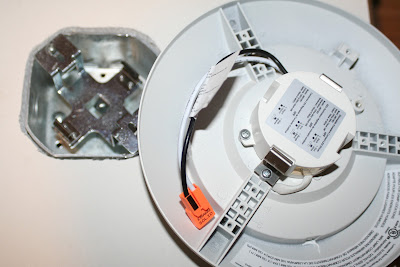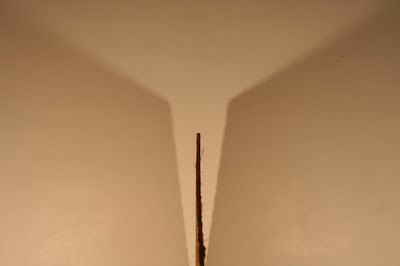
At April, 2016, this post is in revision. Please be patient as I fix the presentation, until it is no longer based on the notion this is a 900 lumens downlight.
I have been installing these lights since mid-January, 2016, where they came in to Lowe's stores at about the first of the year with no fanfare. Appearance match to Sylvania lights they displaced is obvious, and I will not be the only person who thought they must be 900 lumens light, not the box-labeled 700 lumens.
The following table is true, taking momentary watt readings with a Kill-A-Watt meter.
I mustaccept that Utilitech 0752125 is 700 lumens. Maybe a bit more. It is strange then that it could draw up to fifteen watts, while the older-technology Sylvania 72089, also 700 lumens, draws ten or eleven watts. Surely the Utilitech is an energy waster somehow.
Some inefficiency is in an adverse profile. There is no progress in setting the light engine deeper in the luminaire. The number of diodes is reduced from about 26, to 9, while diode size is cut in hlaf. Surely diode luminance is up by an order of magnitude, at a time that luminance as blinding glare, is recognized as a product defect.
Installers will be happy with versatile features for retrofit in most can lights, now to be pulled up simply with springs engaging can harps. Can attachment clips identical to those of Sylvania packaging are also provided. This is the best packaging I have seen, for can retrofits. It is best packaging too, for clipping to a deep ceiling junction box.
A new concept for clipping to a ceiling junction box may be this light's best feature. Keys guide the luminaire to its point of spring-detent engagement. The junction box must be slightly recessed in the ceiling. The box here is RACO 175 in a mating mockup, without power leads.
With about 1/8" recess of the junction box, expect perfect mating with the ceiling. Know the luninaire is easily pried from its secure spring engagement. One should not need a pry tool.
Here is Sylvania 72089, 700 lumens, 10 watts, at left, and 1020 lumens 13 watt Nicor DLS56 at right, at full power through a Cooper DAL06P dimmer. I accept that the brightness difference is by ratio 1020/700, 46% brighter at right.
Here is Sylvania 72089, 700 lumens, 10 watts, at left, and Utilitech #0752125 at right, at full power through a Cooper DAL06P dimmer. The Utilitech is brighter, but by perhaps only 10%.
And at 4/6/2016 here is the same comparison, with Utilitech 0752125, date code 0216. This time, Utilitech 0752125 is at left. Sylvania 72089 is at right. The lights are much more nearly, equal. I am inclined to think product design changed at the 0216 date code, but that is not true although there are visible product changes in addition to advance of date code; the date code 0216 lens is more blue and shiny, less pretty.
Make a direct comparison, Utilitech 0752125 date code 0216 at left, date code 0915 at right. The date code 0216 light seems less bright by a negligible small amount.
Here is the 1020 lumens Nicor DLS56 at left and Utilitech #0752125 at right, at full power from a Cooper DAL06P dimmer. The Utilitech #0752125 is less bright by about the expected amount for 900 lumens rating. Both are pretty 3000°K.
Brightness Comparisons to "65 watt" flood bulbs:
Here and for all photos of this post, find original postings with captions in a Picasa web album .
Six bulbs in sequence are set at stage right in my comparison test stand, with offered advantage. The bulbs are closer to the screen by distance ratio 36"/40", and are not diminished by can light recess. In photos below, proceed counter clockwise from left. Utilitech #0752125 stage left. Comparisons are at full power except as noted.
Where reflector flood lights are taken as comparable to LEDs with 120° beam angle, expect Utilitech at about 900 lumens, to be brighter than floods bout 650 lumens, by about 40% . The comparison is difficult where color temperatures are not matched.
Stage right: GE Reveal Incandescent 65 watts actual.
Stage right: 65 watts incandescent, no manufacturer marking.
Stage right: FEIT Conserv Energy CFL flood, 15 watts.
Stage right, Commercial Electric (Home Depot) 16 watt CFL flood.
Stage right, 670 lumens 65 watts actual, GE incandescent flood. Again an incandescent flood gives decent light, though short-lived and expensive. Is it dimmable?
Incandescent floods are NOT dimmable. This comparison is at about 30% power.
Try one more light at stage right, a Philips LED PAR30 spot, 750 lumens, 13 watts, 3000°K.
Dim to about 30%, since the Philips LED spot is labeled "dimmable." I think a spot light should just be made smaller if less brightness is wanted. A spot bulb is not for practical general illumination. This LED spot was quite expensive and is inordinately heavy. Surely it would not survive a drop, while the Utilitech #0752125 will.
Where a 13 watt Utilitech #0752125 replaces a 65 watt incandescent flood, savings are by more than the 80% of ratio 13/65. If you dim to matched brightness, by 40%, the savings go up. Make a fuller cost comparison including cost of replacements in a matched 50,000 hour service period:
Relate these numbers to savings claimed on the Utilitech #0752125 package:
13 watts * 3 hr/day * 365 days * $0.11 per KW. Estimated Energy Cost $1.57 per year. This simple math is correct.
$286 lifetime savings vs. a 65 watt incandescent with life of 2000 hours.
My math has $569 - 252 = $317 lifetime cost difference where on average, LED dimming 50% or having half as many LEDs, gives match to dim lighting we used to accept, with 100 watt point-source bulbs. If in fact, doubled brightness is valued and maintained, savings are doubled. There are yet more savings where energy bleeds at hacked-in can lights are replaced with junction boxes.
Numbers like $327, or double that, are real but not easily understood. A basis for the $286 box claim is yet harder to understand where lights are not fully comparable. Savings more than ten times the product cost, sound good. Real savings are much bigger, and we need to see this.
I offer another use of the table, in seeing how far we have come in reducing operating cost of lighting. Divide the $569 Utilitech savings number by the total cost of getting same illumination from 100 watt light bulbs, $78 + 550 = $628. See that operating cost is down by 91%. I think that at our best, we will reduce that cost by 95%, where electricity is grid-supplied. Go to 100% with good LED lights and power self-produced off-grid. Lowe's is part of a really good thing, moving away from LED as dim, fragile, point-source bulbs. Let's celebrate. And, let's admit that in the useful math, we need Brightness Numbers. Fix the packaging error, with a new kind of number.
Controlling Luminance
A fully-revealed LED downlight should not be uncomfortable to look at. This is a design concern that has been neglected, perhaps until now. The reduced lumens output from same-size disk in the current Lowe's shelf offering, has more-pleasant luminance.
Luminance is the phenomenon sensed in looking at, a light. If the glare of individual diodes is knocked down by the obscuring lens, and is fully dispersed on the lens, this table works. In fact, there is some failure on both counts of the dispersion attempt. The individual so-bright diodes are not fully obscured.
The light emission is from a very tiny total surface are of diodes. Just nine, about 3/32" diameter phosphors.
Behind the lens, the diodes are screamingly bright. Is this the best we can do? Can't we get the same illumination from much-larger diode surface area? I imagine there is constant progress in product design. Yet, there are steps backwards with this product. Why should there be diminished efficacy, not still pushing toward or beyond, 100 lumens per watt? Why has the manufacturer in China accepted design that is objectionably noisy on a dimmer? Why can't we choose less-wasteful packaging, as is done with all Nicor LED downlights?
Should we speak of something like "perceived diameter" in the lighting density, luminance table? Here the light engine diameter (edge of circuit board), is 2.5", and might approximate what captures our gaze-at-the-light. This is interestingly similar to that of the good old 100 watt incandescent light bulb. Are we perhaps wrongly, again tying ourselves to past convention? If we do stick with the convention, then luminance of the 2.5" board, however packaged, might be limited to 100 watt bulb B4 illuminance, 450 or 500 received lumens over beam angle up to 180°. Luminaires at greater than B4 should have correspondingly larger perceived diameter, by an area ratio.
Lowe's surely is not "done" with this light. In future offering, might there be other options sharing the so-improved mounting features? I wish for options of 500 lumens and 1000 lumens too, at best-available efficacy, and with luminance never worse than in this offering?
I have gone further in study of this light, in blog post Luminaire Luminance Definitions .

The light engine of a luminaire should be set near the lens, not at all recessed and with minimum loss of efficiency in opacity of the lens. Compared to first-version Sylvania 70732 or Sylvania 72089, Utilitech 0752125 is a big step in wrong directions.
The evolution of luminance in 1000 lumens luminaires is also in the direction of worsening glare.

























No comments:
Post a Comment